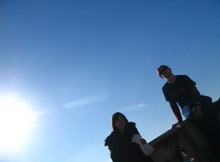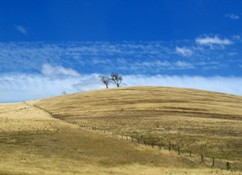Presently enjoying the eyepopping colour and tumultuous composition of the work from German illustrator Olaf Hajek's monograph Flowerhead.
Via my love for you
Jan 29, 2010
This is why I get no sleep...
...Because I discover things like the Polaroid House, on places like flickr, and find them so endlessly fascinating that I spend hours trawling through hundreds of photos, wishing I was cool enough to come up with such fantastic ideas, or, failing that, lucky enough to witness such brilliance in person. Sadly, this is not to be, as is made all too clear by the title of the Polaroid House's flickr pool, 'RIP Polaroid House'.
The Polaroid House is the brainchild of American flickr member, Kim, who found an abandoned house an hour north of California back in 2008. In an interview on www.holgablog.com, she says
"...it really struck something inside me and i knew i would be back. it was so quaint, representing a bygone era in its craftsman styling. the decay of the house and the decay of that era..."
Kim and her friends returned to the house armed with hundreds of polaroids, and covered both the walls and floors with them. A think carpet of photographs, and a polaroid wall ready to be replenished and reworked by future visitors. And they came in their droves, if the sheer number of photos in the flickr pool is anything to attest by. Unfortunately, some visitors failed to respect (or understand?) the nature of the project, and large numbers of polaroids were taken, holes were kicked in the walls. In April 2009, the owner of the house contacted Kim, stating that whilst she had understood and appreciated the installation at first, she was disappointed by the fact that the house was being trashed. The Polaroid House was dismantled, only to live on in the hundreds of photos collected on flickr. And to be endlessly oggled at by one girl on the other side of the world, long past her bedtime.
1 from leah | ohheygreat
2 from Gotfish / Marc Briggs
6 from Gotfish / Marc Briggs
8 from iFaMusicNerdEntOgrapher
Jan 22, 2010
Hanging out with Susan and John

Magritte, La Clef des Songes, 1930. Reproduced on the cover of Ways of Seeing.
On my reading list this summer: On Photography by Susan Sontag and Ways of Seeing by John Berger. They belong to the list of iconic art history texts that I have always felt guilty about failing to read. Well, guilty no more: I can happily move them from my 'to read' to my 'done and dusted' booklist. Some of my favourite snippets:
Through photographs, the world becomes a series of unrelated, freestanding particles; and history, past and present, a set of anecdotes and faits divers. The camera makes reality atomic, manageable, and opaque.
-- Susan Sontag, On Photography chapter one, In Plato's Cave
If I could tell the story in words, I wouldn't need to lug a camera.
-- Lewis Hine, On Photography, anthology of quotations
Photography is a system of visual editing...Like chess or writing, it is a matter of choosing from among given possibilties, but in the case of photography the number of possibilities is not finite but infinite.
-- John Szarkowski, On Photography, anthology of quotations
Seeing comes before words. The child looks and recognises before it can speak. But there is also another sense in which seing comes before words. It is seeing which establishes our place in the world.
-- John Berger, Ways of Seeing
The way we see things is affected by what we believe... when an image is presented as a work of art, the way people look at it is affected by a whole series of learnt assumptions about art.
-- John Berger, Ways of Seeing
The art of the past no longer exists as it once did. Its authority is lost. In its place there is a language of images. What matters now is who uses that language for what purposes.
-- John Berger, Ways of Seeing
A longtime crush
The XX first fluttered by me in about November, and since then, I have been unable to get them out of my head, unable to stop crushing on the sweet airiness of their songs. On the one hand I am scared of killing them through overplaying, but on the other, there is almost nothing that calms me quite like Islands. Magical.
Oh Wooster Collective...
...why oh why did I abandon you for so long? Fool.
1. Anonymous letterbox man
2. SUSO33 in Madrid
3. From the "Mattress" series, Brian Hunter
All images from Wooster Collective.
Jan 20, 2010
A belated goodbye to 2009

December was a very full month indeed. Staking out street art (these two by Miso), a day trip to Daylesford to reunite with some Rome-ey faces, a work christmas party complete with dad-jokes, an encounter with Mr Bond at Armadale station, and to cap it all of, a Day of the Dead themed New Year's Eve party, with discoball, smoke machine, multiple pinatas and a late night swim. Is it any wonder it's taken me so long to get around to putting these up? Ahhh December, will you ever cease to delight and exhaust me? No, most likely not.
Jan 12, 2010
More from the motherland: Laurence Aberhart
So, 2009 was supposed to be my 'Year of the Photo.' Over it may be, but that certainly doesn't mean the obsession with photography has come to an end. If anything, it's only growing. These works from Kiwi photographer Laurence Aberhardt make me
a) itch with the desire to learn darkroom developing
b) homesick for the quiet, sunbaked spaces of Northland (the buildings depicted are all Maori churches)
c) appreciate yet again, the skill with which photographers wield inherent geometry to create pleasing compositions.
a) itch with the desire to learn darkroom developing
b) homesick for the quiet, sunbaked spaces of Northland (the buildings depicted are all Maori churches)
c) appreciate yet again, the skill with which photographers wield inherent geometry to create pleasing compositions.
Another key to why I like Aberhart so much can be found in his subject matter: Maori churches. Despite their quiet stillness, the churches also occupy a difficult (even fraught?) territory in that they are a strange fusion of Maori and Western culture. He who says 'look at the awful missionaries, forcing their faith on the maori' forgets that the Maori were active participants in cultural exchange at the time of settlement, and that the Ratana church arose from Maori taking elements of Western religion which they approved of and melding them with pre-existing tribal religion. To stand in a Maori church is to stand at the borderline of multiculturalism, Aberhart treads this borderline with delicay, and the result is the poignant beauty seen above. In an article by Dutch curator Marja Bloem, Aberhart is quoted as saying that he is "an eclectic collector of cultural debris, as it washes up, and before it disappears." I think the debris he collects is very breathtaking indeed.
Jan 5, 2010
Another like
My mum tells me they are awfully uninteresting, but despite this, I have a bit of a thing for photos of people looking at art. They way everyone interacts with paintings differently, the way small details are noticed, examined, the way a large scale sculpture or installation can enter and alter a spectator's personal space. I only realised just how much I liked the people-looking-at-art shot several years after making my way around the Louvre and Museé d'Orsay, but lucky for me, the talented Jen Gotch of my polaroid blog has some dreamy, light-filled shots of the Louvre. Meanwhile, I will make do with the (somewhat gloomy) NGV. Tant pis.
1, 2, 3, 4 from Jen Gotch's flickr set, april in paris.
5. John Brack at NGV Australia
6. The Satirical Eye at NGV International
7. 'The Italian Room,' NGV International
8. Bugatti Family at NGV International
9. Janet Cardiff & George Bures Miller at ACMI
Jan 4, 2010
I like these very much...
AKA I am both slack, and epically busy with work, and I apologise for not posting for such along time. Can I make up for said slackness with beautiful underwater photos by Bahama-based photogapher Elena Kalis? I sure hope so.
More underwater gloriousness here.
Subscribe to:
Posts (Atom)
+of+DSCN2645-pola.jpg)




































































.jpg)













